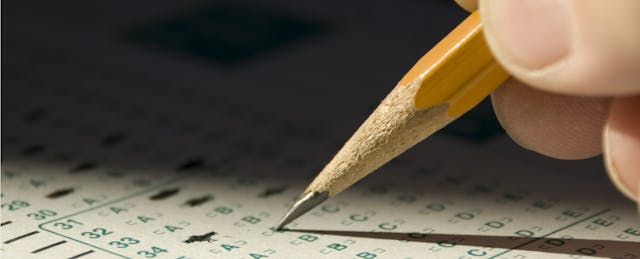This is the first part of a two-part story looking at how MIT researchers are developing playful assessments to measure student growth. Read part two to learn about how one school is implementing this work.
In recent years, educators have spent countless collective hours designing, experimenting with and implementing new kinds of learning experiences for students—learning experiences that are fun, engaging and formative. But assessments haven’t evolved at the same pace.
As a result, there is a disconnect between what schools value and what they measure. But it’s a tough nut to crack, because many of the skills and characteristics treasured most are in fact the hardest to evaluate.
That’s why a team of education researchers at MIT has embarked on an ambitious project to address the missing link—measuring outcomes—that so often holds back new-age learning environments. They’re calling it “playful assessment.”
Playful assessment, not to be mistaken for gamification, seeks to capture student mastery in many of the areas that are hard to gauge. Louisa Rosenheck, a research manager at MIT with experience in game design, says the idea is to measure “all the things we say we care about”—like curiosity, creativity and critical thinking—but that traditional assessments miss. “By making assessment playful, we can get closer to measuring the things we actually value,” she says.
The beauty of playful assessment, she says, is that it can be done without interrupting the rhythm of learning, thereby alleviating student anxiety around testing. “Kids don’t even have to know they are being assessed,” Rosenheck tells EdSurge.
It’s not just students who find traditional assessments “threatening,” adds Yoon Jeon Kim, the project lead and MIT researcher with expertise in assessment science. “Teachers are evaluated on those standardized tests. They have high anxiety about it, too. They do assessments because they have to.”
“Playful assessment is a punch to that notion of assessment being so serious,” Kim continues. “I think it could change, really, how schooling is done.”
So, what does playful assessment look like? Much of it, as Rosenheck envisions it, hinges on self-reflection and peer evaluation. “We want students to be able to recognize for themselves what is quality work,” she explains. But teachers need support to design learning experiences where these kinds of assessments can be embedded, and to develop assessments that are tailored to what students are learning.
Researchers at the MIT Teaching Systems Lab (TSL) have been pursuing this body of work for several years, but only dubbed it “playful assessment” in the last year. In that time, they’ve pursued a few distinct strands of this work, including the development of a playful activity to help teachers build better rubrics and the implementation of a pilot for playful assessment in schools—which EdSurge got to see first-hand.
Going Meta on Building Rubrics
Researchers at the lab understand that while “most people recognize the limitations of standardized testing,” they may still rely on it because it’s hard to know what to do instead. So they’re trying to offer teachers an alternative.
Rubrics have long been a popular tool for educators looking to experiment with alternative ways of capturing growth. Anyone can build them, and they can be adapted for any topic or project. But building effective rubrics is no easy feat, especially when it comes to measuring growth for non-academic areas like creativity and out-of-the-box thinking.
MIT researchers want to help teachers craft more effective rubrics to measure those areas that are hard to quantify, so they’ve developed an activity called MetaRubric—and in the name of keeping things playful, it’s designed to be fun for teachers.
Part card game, part discussion group, the activity asks players—in this case, teachers—to participate in a short, open-ended assignment that requires some creativity. Players then circle back to evaluate their own project, and ultimately collaborate to build a shared MetaRubric (a rubric that lays out the qualities of a good rubric).

It’s one thing for schools to recognize that traditional assessments aren’t capturing a complete picture of student growth. It’s another for them to decide to shift toward a new way of evaluating that growth. Two schools, one in California and another in Virginia, have taken the plunge and are actively using MIT’s new playful assessment tools with their students.
Piloting Playful Assessment
Maker-centered learning, which encourages tinkering, hacking, building and all things hands-on, fosters skills like creativity, problem solving and agency. But it’s difficult to measure many of the skills associated with maker education.
With insight and oversight from MIT and Maker Ed (a nonprofit partner of MIT), and funding from the National Science Foundation (NSF), two dissimilar schools are implementing a new set of assessment tools designed to gauge student mastery in making.
“We picked two quite different middle schools so we can say the iteration of these tools and methods could work for any type of learning environment,” Stephanie Chang, director of impact at Maker Ed, tells EdSurge. (They were limited to just two schools because of the duration and scope of the NSF grant.)
Corte Madera School, a public K-8 school in San Mateo, Calif., is implementing MIT’s “Beyond Rubrics” framework to demonstrate whether and how a traditional school could implement playful assessment. Corte Madera uses traditional curriculum and assessment on commonly taught subject areas, has standard class periods and has a shared physical makerspace that students visit during lunch, recess or when their teacher signs up to use it.
On the other end of the spectrum is Community Public Charter School (Community Middle) in Charlottesville, Va. Community Middle is a lab school for the Albemarle County School District and offers what Rosenheck calls “ideal conditions” for this project.
At Community Middle, scoring and report cards have been set aside. Class distinctions among sixth, seventh and eighth grades have all but disappeared. It’s not unusual for a group of classmates to be pursuing wildly different activities simultaneously. One might be playing piano in the hallway, while another builds a model engine in a nearby room and a third operates a power drill in a lab. These students rarely take multiple choice tests. Instead, they participate in projects that build capacities and skills, and they either master those skills or they don’t.
MIT and Maker Ed have worked closely with both Corte Madera and Community Middle to pilot seven measurement tools they’ve developed to illustrate that maker education is not only engaging, but effective, too.
Read more about MIT’s pilot project at Community Public Charter School here.
What’s Next for Playful Assessment?
Rosenheck, Kim and their colleagues at MIT will continue to workshop and expand their ongoing playful assessment projects. The team is also working on a third project: a digital, game-based assessment system that can evaluate subject matter knowledge as well as cognitive and non-cognitive skills like spatial reasoning, persistence and creativity. They believe it could eventually replace traditional math exams, including multiple choice tests.
There is still much to be researched, tested and understood before playful assessment is something that can be introduced in classrooms everywhere, Rosenheck says. The absence of a familiar score or letter grade, for example, is something she and Kim expect will get pushback.
“I think, in the foreseeable future, the best we can hope for is a middle ground where teachers are excited and comfortable doing these creative, playful assessments,” Rosenheck says, but she predicts that schools will need support to translate the findings into a grade or some other form to communicate growth.
For the most progressive schools, however, that won’t be necessary. Albemarle’s Community Middle school is proof. Rosenheck has been on the ground at the Virginia lab school, and while she calls it bold and perhaps a bit radical, “it’s going in a direction we would love to envision for all schools,” she says.
Read more about what it’s like inside Albemarle’s lab school, and how the school is using MIT research concepts and tools to assess maker-centered, project-based learning.


